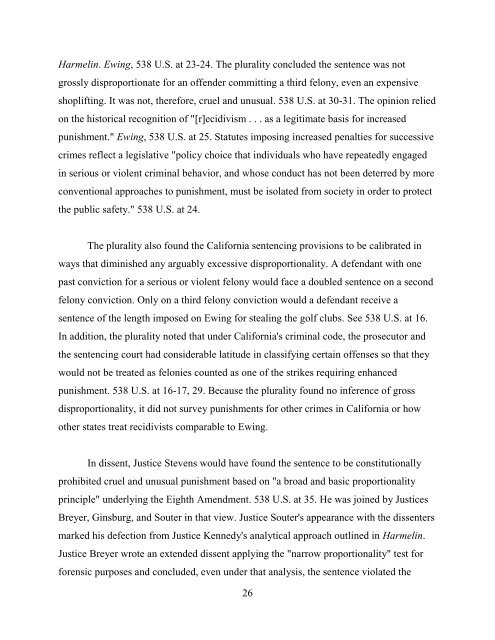State v. Proctor - Kansas Judicial Branch
State v. Proctor - Kansas Judicial Branch
State v. Proctor - Kansas Judicial Branch
You also want an ePaper? Increase the reach of your titles
YUMPU automatically turns print PDFs into web optimized ePapers that Google loves.
Harmelin. Ewing, 538 U.S. at 23-24. The plurality concluded the sentence was not<br />
grossly disproportionate for an offender committing a third felony, even an expensive<br />
shoplifting. It was not, therefore, cruel and unusual. 538 U.S. at 30-31. The opinion relied<br />
on the historical recognition of "[r]ecidivism . . . as a legitimate basis for increased<br />
punishment." Ewing, 538 U.S. at 25. Statutes imposing increased penalties for successive<br />
crimes reflect a legislative "policy choice that individuals who have repeatedly engaged<br />
in serious or violent criminal behavior, and whose conduct has not been deterred by more<br />
conventional approaches to punishment, must be isolated from society in order to protect<br />
the public safety." 538 U.S. at 24.<br />
The plurality also found the California sentencing provisions to be calibrated in<br />
ways that diminished any arguably excessive disproportionality. A defendant with one<br />
past conviction for a serious or violent felony would face a doubled sentence on a second<br />
felony conviction. Only on a third felony conviction would a defendant receive a<br />
sentence of the length imposed on Ewing for stealing the golf clubs. See 538 U.S. at 16.<br />
In addition, the plurality noted that under California's criminal code, the prosecutor and<br />
the sentencing court had considerable latitude in classifying certain offenses so that they<br />
would not be treated as felonies counted as one of the strikes requiring enhanced<br />
punishment. 538 U.S. at 16-17, 29. Because the plurality found no inference of gross<br />
disproportionality, it did not survey punishments for other crimes in California or how<br />
other states treat recidivists comparable to Ewing.<br />
In dissent, Justice Stevens would have found the sentence to be constitutionally<br />
prohibited cruel and unusual punishment based on "a broad and basic proportionality<br />
principle" underlying the Eighth Amendment. 538 U.S. at 35. He was joined by Justices<br />
Breyer, Ginsburg, and Souter in that view. Justice Souter's appearance with the dissenters<br />
marked his defection from Justice Kennedy's analytical approach outlined in Harmelin.<br />
Justice Breyer wrote an extended dissent applying the "narrow proportionality" test for<br />
forensic purposes and concluded, even under that analysis, the sentence violated the<br />
26

















